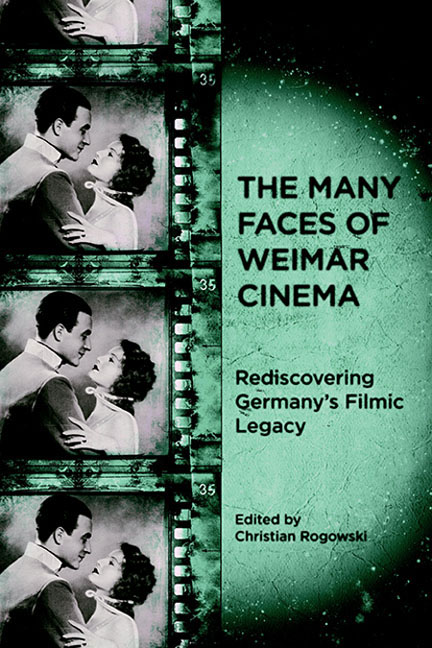Book contents
- Frontmatter
- Contents
- List of Illustrations
- Preface
- Introduction: Images and Imaginaries
- 1 Richard Oswald and the Social Hygiene Film: Promoting Public Health or Promiscuity?
- 2 Unsettling Nerves: Investigating War Trauma in Robert Reinert's Nerven (1919)
- 3 Humanity Unleashed: Anti-Bolshevism as Popular Culture in Early Weimar Cinema
- 4 Desire versus Despotism: The Politics of Sumurun (1920), Ernst Lubitsch's “Oriental” Fantasy
- 5 Romeo with Sidelocks: Jewish-Gentile Romance in E. A. Dupont's Das alte Gesetz (1923) and Other Early Weimar Assimilation Films
- 6 “These Hands Are Not My Hands”: War Trauma and Masculinity in Crisis in Robert Wiene's Orlacs Hände (1924)
- 7 The Star System in Weimar Cinema
- 8 Schaulust: Sexuality and Trauma in Conrad Veidt's Masculine Masquerades
- 9 The Musical Promise of Abstract Film
- 10 The International Project of National(ist) Film: Franz Osten in India
- 11 The Body in Time: Wilhelm Prager's Wege zu Kraft und Schönheit (1925)
- 12 Henrik Galeen's Alraune (1927): The Vamp and The Root of Horror
- 13 The Dialectic of (Sexual) Enlightenment: Wilhelm Dieterle's Geschlecht in Fesseln (1928)
- 14 Babel's Business — On Ufa's Multiple Language Film Versions, 1929–1933
- 15 “A New Era of Peace and Understanding”: The Integration of Sound Film into German Popular Cinema, 1929–1932
- 16 Landscapes of Death: Space and the Mobilization Genre in G. W. Pabst's Westfront 1918 (1930)
- 17 Undermining Babel: Victor Trivas's Niemandsland (1931)
- 18 Unmasking Brigitte Helm and Marlene Dietrich: The Vamp in German Romantic Comedies (1930–33)
- Filmography
- Notes on the Contributors
- Index
3 - Humanity Unleashed: Anti-Bolshevism as Popular Culture in Early Weimar Cinema
Published online by Cambridge University Press: 29 April 2017
- Frontmatter
- Contents
- List of Illustrations
- Preface
- Introduction: Images and Imaginaries
- 1 Richard Oswald and the Social Hygiene Film: Promoting Public Health or Promiscuity?
- 2 Unsettling Nerves: Investigating War Trauma in Robert Reinert's Nerven (1919)
- 3 Humanity Unleashed: Anti-Bolshevism as Popular Culture in Early Weimar Cinema
- 4 Desire versus Despotism: The Politics of Sumurun (1920), Ernst Lubitsch's “Oriental” Fantasy
- 5 Romeo with Sidelocks: Jewish-Gentile Romance in E. A. Dupont's Das alte Gesetz (1923) and Other Early Weimar Assimilation Films
- 6 “These Hands Are Not My Hands”: War Trauma and Masculinity in Crisis in Robert Wiene's Orlacs Hände (1924)
- 7 The Star System in Weimar Cinema
- 8 Schaulust: Sexuality and Trauma in Conrad Veidt's Masculine Masquerades
- 9 The Musical Promise of Abstract Film
- 10 The International Project of National(ist) Film: Franz Osten in India
- 11 The Body in Time: Wilhelm Prager's Wege zu Kraft und Schönheit (1925)
- 12 Henrik Galeen's Alraune (1927): The Vamp and The Root of Horror
- 13 The Dialectic of (Sexual) Enlightenment: Wilhelm Dieterle's Geschlecht in Fesseln (1928)
- 14 Babel's Business — On Ufa's Multiple Language Film Versions, 1929–1933
- 15 “A New Era of Peace and Understanding”: The Integration of Sound Film into German Popular Cinema, 1929–1932
- 16 Landscapes of Death: Space and the Mobilization Genre in G. W. Pabst's Westfront 1918 (1930)
- 17 Undermining Babel: Victor Trivas's Niemandsland (1931)
- 18 Unmasking Brigitte Helm and Marlene Dietrich: The Vamp in German Romantic Comedies (1930–33)
- Filmography
- Notes on the Contributors
- Index
Summary
Don't shoot me!” the director yelled. Then he gave the order to attack: an infernal noise started, machine guns firing, spotlights flooding the ground, and soldiers in army uniform began to climb the barricades of the Spartacist rebels. On 13 March 1920, under the guidance of Joseph Delmont, Die entfesselte Menschheit (Humanity Unleashed) was being filmed in the studios at the Zoo in Berlin. At the very same time, not far outside, another insurrection was taking place, a real one: an ultraright-wing military group led by Wolfgang Kapp seized control of strategic buildings in the German capital and forced the democratically elected government to leave the city. Yet this effort to restore the monarchy failed to garner the support of the civil service and the population: after only four days, the so-called Kapp-Putsch collapsed.
The two incidents — the shooting of Delmont's film and the attempted coup d'état — reflect both the imaginary and the real threat to the young Weimar Republic. For years, extreme groups on both ends of the political spectrum sought to undermine the stability of the state through acts of political violence: in January 1919 the Spartacists had staged an unsuccessful attempt at fomenting a Communist uprising; throughout 1919 and 1920 violent clashes between revolutionary workers and the authorities occurred in different parts of Germany; right-wing militias committed politically motivated murders, and civil war seemed imminent.
Delmont's Die entfesselte Menschheit clearly reflects a growing fear of political radicalization, here associated with violence from the Left. For the broad majority of the German public, dominated by the mainstream bourgeois press, Bolshevism (and its near-synonym, Spartacism) embodied the danger of total collapse of the German Reich, symbolizing civil war, chaos, and anarchy. Anti-Bolshevism ran across a broad spectrum, ranging from Social Democrats, Liberals, and Zentrum Catholics to the political Right, including groups of militarists, monarchists, anti-Socialists, and former representatives of annexation. The uneasy alliance of these disparate groups mirrored the Burgfrieden (political truce) of the war years, shifting the focus from the wartime fight against enemies on the outside to a postwar fight against the perceived enemies within. Similar to the “red scare” that grabbed the United States after the First World War, this ideology in defense of the state can be described as ”radical anti-radicalism” (Murray, 279).
- Type
- Chapter
- Information
- The Many Faces of Weimar CinemaRediscovering Germany's Filmic Legacy, pp. 48 - 66Publisher: Boydell & BrewerPrint publication year: 2010

